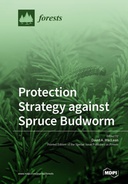Explore

Protection Strategy against Spruce Budworm
David A. MacLean
2020
0 Ungluers have
Faved this Work
Login to Fave
Spruce budworm (Choristoneura fumiferana (Clem.)) outbreaks are a dominant natural disturbance in the forests of Canada and northeastern USA. Widespread, severe defoliation by this native insect results in large-scale mortality and growth reductions of spruce (Picea sp.) and balsam fir (Abies balsamea (L.) Mill.) forests, and largely determines future age–class structure and productivity. The last major spruce budworm outbreak defoliated over 58 million hectares in the 1970s–1980s, and caused 32–43 million m3/year of timber volume losses from 1978 to 1987, in Canada. Management to deal with spruce budworm outbreaks has emphasized forest protection, spraying registered insecticides to prevent defoliation and keep trees alive. Other tactics can include salvage harvesting, altering harvest schedules to remove the most susceptible stands, or reducing future susceptibility by planting or thinning. Chemical insecticides are no longer used, and protection strategies use biological insecticides Bacillus thuringiensis (B.t.) or tebufenozide, a specific insect growth regulator. Over the last five years, a $30 million research project has tested another possible management tactic, termed an ‘early intervention strategy’, aimed at area-wide management of spruce budworm populations. This includes intensive monitoring to detect ‘hot spots’ of rising budworm populations before defoliation occurs, targeted insecticide treatment to prevent spread, and detailed research into target and non-target insect effects. The objective of this Special Issue is to compile the most recent research on protection strategies against spruce budworm. A series of papers will describe results and prospects for the use of an early intervention strategy in spruce budworm and other insect management.
This book is included in DOAB.
Why read this book? Have your say.
You must be logged in to comment.
Rights Information
Are you the author or publisher of this work? If so, you can claim it as yours by registering as an Unglue.it rights holder.Downloads
This work has been downloaded 296 times via unglue.it ebook links.
- 254 - pdf (CC BY-NC-ND) at Unglue.it.
Keywords
- Abies balsamea
- Acadian region
- aerobiology
- annual defoliation
- apparent fecundity
- area-wide management
- Choristoneura fumiferana
- Choristoneura fumiferana (Clem.)
- Choristoneura fumiferana (Clemens)
- Circadian Rhythm
- computable general equilibrium model
- decision support system
- defoliation
- defoliation prediction
- dispersal
- Early Intervention
- early intervention strategy
- economic and ecological cost: benefit analyses
- economic losses
- egg recruitment
- endophytic fungi
- foliage protection
- forest pests
- forest protection
- growth rate
- hardwood content
- Immigration
- insect population management
- insect susceptibility
- insecticide application
- insecticides
- intertree variance
- Lepidoptera
- Maine
- migration
- mixed effect models
- modelling
- Monitoring
- Moth
- Moths
- multi-spectral remote sensing
- optimized treatment design
- phenology
- pheromone mating disruption
- Phialocephala scopiformis
- Picea glauca
- Pinaceae
- plant tolerance
- population control
- Québec
- science communication
- simulation
- spatial autocorrelation
- spatial-temporal patterns
- spruce budworm
- Survival
- thema EDItEUR::P Mathematics and Science::PS Biology, life sciences
- tortricidae
- treatment threshold
Links
DOI: 10.3390/books978-3-03928-097-1Editions


